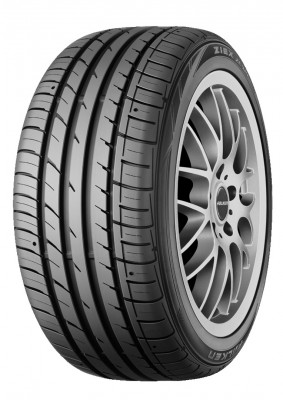

The tires must be rated heavy enough to carry the load. There is no torque applied to the tires, as they are free-rolling. The sprayer will only travel as fast as the tractor that is pulling it. There are a variety of different sizes and tread designs used, including R-1, R-1W, and R-3. Tires are not as critical on these as on self-propelled sprayers. Generally, the tanks on these sprayers are smaller and carry less fluid. Some sprayers are made as pull -behind sprayers. If standard farm tires are used in a sprayer application, they will generally fail in the sidewall at the ply turn-up, a few inches above the bead. The high weight carrying capacity and speed are not needed in this application. Although there are a few high-speed tractors on the market that run from 40 to 45 miles per hour, most of the common farm tractors run about 30 miles per hour. The R-1Ws have a few less lugs per tire and have a deeper tread depth. Standard tractor tires can be R-1s, but many are R-1Ws. Regardless of the width and size of tires used, they must be able to handle the speed and the weight to minimize the potential for tire failure. Once crops are planted, narrow tires are used to fit between the rows.

Wider tires are sometimes used for flotation and less compaction before planting. Self-propelled sprayers can be retrofitted with different tire sizes according to the region of the country they are in and when they are being used. Again, dealers should be careful to make sure that the tires used can carry the weight of the load and are rated for the speed.

These smaller sprayers don’t have the heavy weight and run the high speed of the larger sprayers. There are smaller self-propelled sprayers on the market that require smaller tires. The VFs are better in this application because of the higher load carrying capacity. Since air carries the weight, the IF and VF tire are rated for a higher air capacity than standard tires. For this application, tires should be IF- (20% more load than a standard tire) or VF (40% more load than a standard tire)-rated to carry the excess weight. Traction is generally not as much of a concern for sprayers as it is for tractors. An R-1 has more lugs - or less void ratio- for highway contact and a shallower tread depth for less squirm from the lugs. The tires used for this application must be able to handle the speeds, loads and the highway with some stability. They are driven on the highway to get to the fields. Most modern self-propelled sprayers are heavy and run 40 miles per hour, carrying a lot of liquid weight. There is quite a bit of difference between the standard and VF in speed and load carrying capacity. A standard BKT tractor tire, the RT945 380/90R46 159A8/B, is rated to carry 9,640 pounds at 58 psi at 30 miles per hour.Ī BKT sprayer tire, the VF 380/90R46 Agrimax Spargo, is rated to carry 13,760 pounds at 61 psi at 40 miles per hour. The 380/90R46 is made in a standard tire for tractors and increased flexion (IF) and very high-flexion (VF) versions for sprayers. Standard tires for tractors and tires for sprayers can be the same sizes, which can lead to some confusion.Īn example is 380/90R46, a popular size used on both tractors and sprayers. Question: What is the difference between a row crop sprayer tire and a tractor tire and why is it important to match the correct tire for each application?ĭAVE PAULK, manager, field technical services, BKT USA: Although tractor tires and sprayer tires are used interchangeably at times, there are major differences concerning the two applications. For complete answers, click on (You can access the latest episode of the AG Tire Talk podcast here. A trending question, followed by answers, will appear in our Commercial Tire Dealer section every other month. This is the next installment in our ongoing series, which is designed to help farm tire dealers better connect with their customers.

Modern Tire Dealer has partnered with AG Tire Talk to provide answers to insightful questions that farm tire dealers have about farm tire technology.


 0 kommentar(er)
0 kommentar(er)
